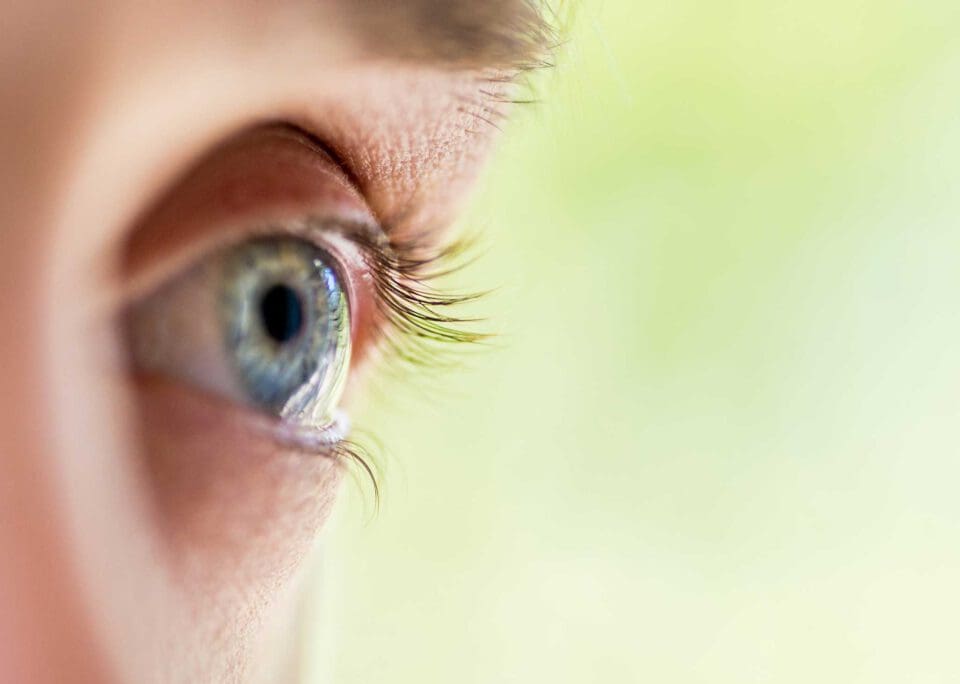Further Reading
The Potential Problems You Need to Know About Orthokeratology
Home / Orthokeratology Guide /
Last Updated:
Table of Contents
Orthokeratology is a process that works similarly to braces for your teeth. A series of specially fitted hard contact lenses are worn overnight for one to four weeks until your cornea is reshaped, and you have clear vision in the mornings after you take the lenses out. Without ongoing treatment with a retainer lens, your refractive error will return.
Many people have found ortho-K to be a great treatment since they are not interested in surgical procedures like LASIK. There are risks, including infection, hypoxia, scarring, and other problems, but these are usually the same as those associated with regular, daily wear of soft contact lenses.
It is important for your ophthalmologist to be trained in orthokeratology. This ensures your lenses will fit securely, your eye health will be monitored, and your vision can be corrected with lower risks.

How Safe Is Ortho-K?
Orthokeratology, or ortho-K, is a treatment that slows the progression of myopia in children and temporarily reverses myopia or astigmatism in adults. It involves specially made, gas-permeable hard contact lenses that you wear for several hours, often while you sleep.
These contacts reshape the cornea, which is the clear part over the pupil that helps to refract light back onto the retina. Misshapen corneas can lead to changes in lens shape, which means you may suffer from blurry or double vision. While the change is impermanent — if you go through ortho-K treatment but then stop wearing your retainer lenses, your eyes will return to their original refractive error — the process is nonsurgical, which is very appealing to many people who are not interested in outpatient procedures like LASIK. The process takes one to four weeks to reshape the cornea, and then you will wear retainer lenses every night to maintain the shape. When you take the lenses out in the morning, your vision will be much clearer, and you should not need glasses or contact lenses.
You deserve clear vision. We can help.
With 135+ locations and over 2.5 million procedures performed, our board-certified eye surgeons deliver results you can trust. Your journey to better vision starts here.
The U.S. Food and Drug Administration (FDA) has deemed orthokeratology a safe treatment for people of many ages, from children to adults, as long as the contact lenses are properly maintained and made of specific, highly gas-permeable materials. Other organizations outside the United States disagree on the safety of orthokeratology. In fact, the Canadian Ophthalmological Society (COS) has deemed ortho-K an unsafe procedure for anyone, especially for children, due to the risk of corneal damage.
It is important to know that these risks can be mitigated. They are about the same as the risks for other types of contact lenses. Awareness of these potential risks can help you make an informed decision.
Risks Associated With Orthokeratology Treatment
Although orthokeratology is safe, it is important to follow good hygiene for your hands and eyes, maintain clean contact lenses, and report any symptoms to your optometrist or ophthalmologist, so you can be appropriately diagnosed and treated if you have a more serious condition like an infection. Potential concerning symptoms include red, dry, burning, painful, or watering eyes.
Conditions associated with orthokeratology include:
- Microbial keratitis. An overview of medical studies and reports on orthokeratology risks found that microbial keratitis, or an infection in the eye, was the most serious consequence of poor orthokeratology practices. If left untreated, an eye infection can lead to reduced vision, poor vision, or even blindness, so any signs of this issue must be reported to a doctor for treatment.The study found that several factors impacted whether patients developed microbial keratitis, such as:
- Following cleaning protocols as instructed.
- Skipped routine follow-up visits on the part of the patient or practitioner.
- Improper fitting procedures, leading to incorrect lens shape over the cornea.
- Lack of training in lens creators or eye doctors.

- Corneal staining, lens binding, and tear film stability. The risk of corneal staining was about the same in those wearing ortho-K lenses and those who wore regular, soft contacts; however, the risk is still present. This condition is caused by eye hypoxia, or lack of air reaching the surface of the eye due to a contact lens on the surface, but it can also be caused by improper lens fitting. Fluorescein penetrates damaged cell membranes in the eye, or fills in gaps on the cells’ surfaces, which were created when cells were damaged or displaced due to problems on the eye’s surface.Higher baseline myopia contributed to the risk of corneal staining. If your ophthalmologist fails to properly fit your ortho-K lenses or does not discuss the risks of high-level refractive errors, you are at risk for this condition. Dry eye symptoms can develop and may not go away due to long-term wear of these hard lenses, and lens binding to the eye due to sleeping in the lenses was a risk, but these were also similar risks as those experienced with soft contact lenses.
- White lesions or epithelial deposits. Iron rings or arcs, and white deposits or lesions, have been reported due to long-term wear of ortho-K lenses. Lesions in particular were associated with a long-term duration of treatment, including wearing the retainer lenses for months or years.
- Corneal thinning. Although there were no other reported epithelial changes, the thickness of the cornea itself was found to greatly lower over time with orthokeratology treatment. This was found at a measurable, significant level within just 24 hours after initiation of the treatment process. The condition typically peaked after one week of overnight treatment.
- Intraocular pressure changes. Although there is concern about eye conditions like glaucoma being triggered by ortho-K in the first days or weeks of treatment, orthokeratology seems to lower eye pressure rather than raise it.
Additionally, if you already suffer from other eye conditions, you should not undergo orthokeratology treatment. Your ophthalmologist should guide you on this process, but if you have any of these counterindications, you are not a good candidate for ortho-K:
- Acute or subacute inflammation or infection in the front of the eye
- Injury, disease, or abnormality that affects the cornea, conjunctiva, or eyelids
- Chronic, severe dry eyes with abnormal tears
- Corneal hypoesthesia, or reduced corneal sensitivity
- Systemic diseases that reduce the ability to wear contact lenses safely
- Allergic reactions on the ocular surface
- Other issues from wearing soft contact lenses
- Allergy to ingredients used to make the orthokeratology devices
- Active corneal infections
- Consistent redness or irritation in the eyes, which could indicate a larger underlying problem also impacting your refractive error
You deserve clear vision. We can help.
With 135+ locations and over 2.5 million procedures performed, our board-certified eye surgeons deliver results you can trust. Your journey to better vision starts here.
Life after Orthokeratology
After orthokeratology, it’s crucial to observe optimal hand and eye hygiene to prevent serious eye issues while ensuring your contact lenses remain clean. Thorough handwashing before handing the lenses is vital for the procedure’s long and short-term success.
Other than hygiene, pay attention to your facial care routines and the products you use on your face. Some facial soaps, makeup, and creams can lead to issues related to deposits on the ortho-k lenses.
Although your lenses have a disinfectant, their cases can be contaminated. As such, you need to replace cases with peroxide systems after every two months and those with GP systems after three to four months.
Doctors recommend wearing your lenses for eight to nine hours every night for the first week after orthokeratology. After that, you should wear them for not less than seven hours a night to guarantee consistent optimal vision the next day.
After the first contact lenses, you will need ongoing treatment with retainer lenses to maintain the shape of your cornea. Failure to use the retainer lenses may cause the cornea to revert to its post-treatment shape and the reversal of your treatment’s results since ortho-k only has temporary results.
Finding the Best Ophthalmologist for Orthokeratology Treatment
If you are interested in orthokeratology, it is important to find an ophthalmologist who understands the procedure, has experience working with patients using this treatment, and a track record of success. You can use a database like the American Academy of Orthokeratology and Myopia Control’s (AAOMC) online search tool, which can help you locate the nearest professional specializing in this type of eye treatment.
While medical literature in the United States focuses on the safety burden for orthokeratology resting on the patient and their hygiene, it is also incumbent on the ophthalmologist to make an appropriate topographical map of the cornea. The doctor also needs to insist on consistent follow-up eye exams, ask about any symptoms that may even mildly bother the patient, and have training specific on this process.
You deserve clear vision. We can help.
With 135+ locations and over 2.5 million procedures performed, our board-certified eye surgeons deliver results you can trust. Your journey to better vision starts here.
References
- What Is Orthokeratology? (September 13, 2018). American Academy of Ophthalmology (AAO).
- What Is Orthokeratology? The American Academy of Orthokeratology and Myopia Control (AAOMC).
- Patient Information Booklet (Part 1) for Potential Users of Rigid Gas Permeable Contact Lenses for Orthokeratology. (September 2, 2015). U.S. Food and Drug Administration (FDA).
- Orthokeratology & Myopia. Canadian Ophthalmological Society (COS).
- The Safety of Orthokeratology – A Systematic Review. (December 28, 2015). Eye & Contact Lens.
- Corneal Staining. Contact Lens Update.
- Contact Lens Problems: Hypoxia. (December 3, 2017). MyHealth Alberta.
- LASIK Eye Surgery Risks vs. Ortho-K Risks. iSee.
- Find an Ortho-K Doctor. The American Academy of Orthokeratology and Myopia Control (AAOMC).
This content is for informational purposes only. It may have been reviewed by a licensed physician, but is not intended to serve as a substitute for professional medical advice. Always consult your healthcare provider with any health concerns. For more, read our Privacy Policy and Editorial Policy.